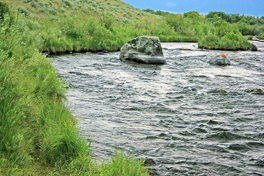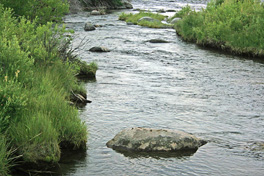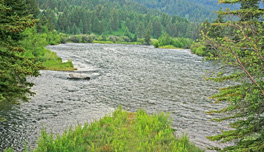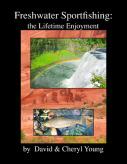Current Seams
My favorite riffle lies are the current seams created by junctures of fast and slow flows. Here the fish enjoy the best of both worlds, a cushion lie with food drifting and depositing at its front door. Fish can rest in these seams and dart out in to the adjacent riffle to capture prey and return back to rest in the seam. Current seams are formed by the nature of current flow. Usually the middle of a riffle contains the fastest flow

with its edges having slower flows due to friction with the bank and the stream bed obstacles. A stream channel’s curvature redirects its heaviest flow away from the remainder of the stream creating current seams. In addition, a riffles surface reflects its stream bed contours; furthermore, riffles vary widely in both depth and speed resulting in multitude areas of current seams which provides desired fish habitat.
A riffles broken surface affords an overhead canopy which obstructs the vision of birds of prey. In this way riffles create protective cover.
The current velocity increases as its stream bed narrow; likewise, wide riffles have slower velocities.
A riffles depth and speed plays a role in its fish holding capability. Some are just too fast and deep for fish to hold in; therefore, look for the moderate and slower riffles to hold fish. Just above or below a basketball sized rock creates a cushion lie just right for fish.
The fastest current is at its surface and it progressively slows down as it reaches its stream bed. The bottom obstructions further decreases the current speed making favorable conditions for aquatic life.
At times when insects are hatching fish migrate to these riffle areas to actively feed. Prior to hatching on the surface, emerging insects are active and exposed next to the stream bed.
Sunlight affects fish activities. A bright overhead sun can illuminate a riffle enough so that birds of prey can spot and sweep down upon fish. This alarms the fish and they avoid these shallows during bright light


conditions. During low light periods fish migrate back to these shallow areas to feed in safety. My favorite conditions are overcast days in which fish feel safe and stay in the shallow riffles feeding throughout the day.
Fall, winter, and spring sunlight is at a lowered angle and doesn’t illuminate the water as well as a high angled summer sun. This causes fish to hold longer in the riffles during the off season.
A spring creeks feeding lies can be just about anywhere that there is an abundance of rooted aquatic plants. Perhaps the best lies are submerged plants for they produce an abundance of insects. Plants act like rocks in a freestone’s riffle by cushioning the currents flow. Rarely will you encounter extensive weed beds in waters too swift for fish to hold. Look for weed beds and fish will be close by especially during an insect hatch.

© 2025 The Gale Group, Inc. All rights reserved.
© 2025 Perigee Learning LLC. All rights reserved.
LoveTheOutdoors.com is owned and operated by Advameg, Inc. © 2025 Advameg, Inc.
Camping Adventures • Dutch Oven Cooking • Sports Knots
Fly Tying • Freshwater Fishing • Fly Fishing

